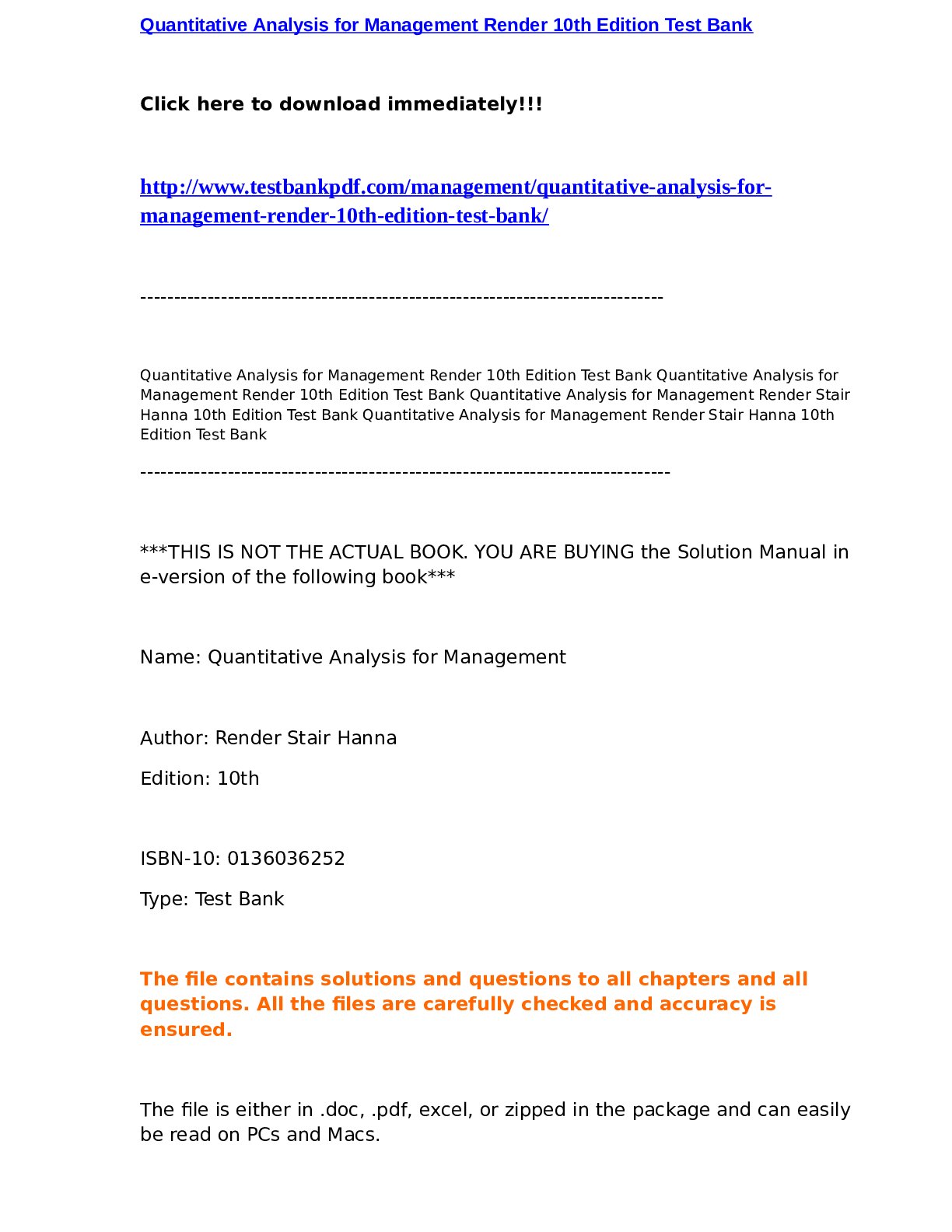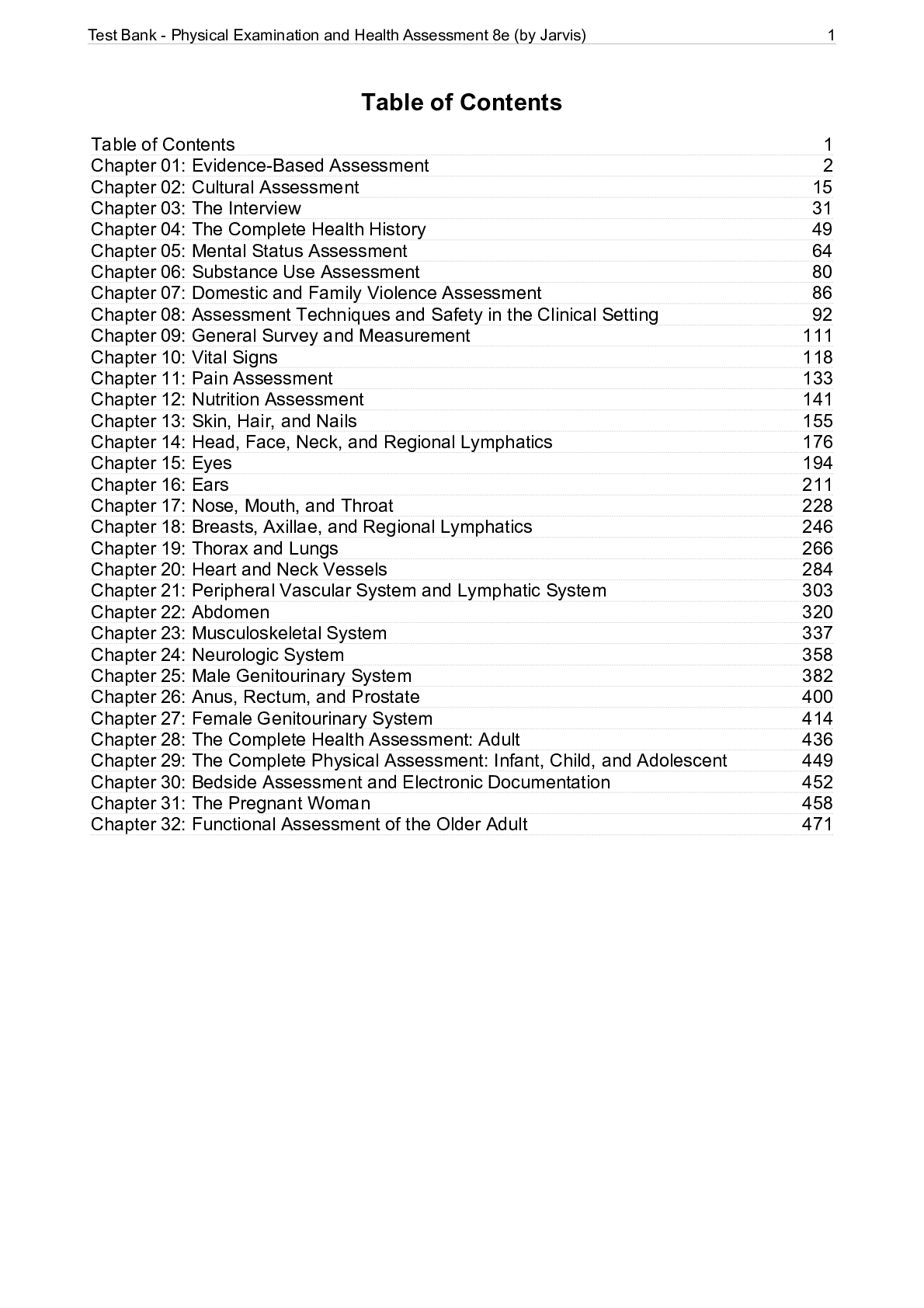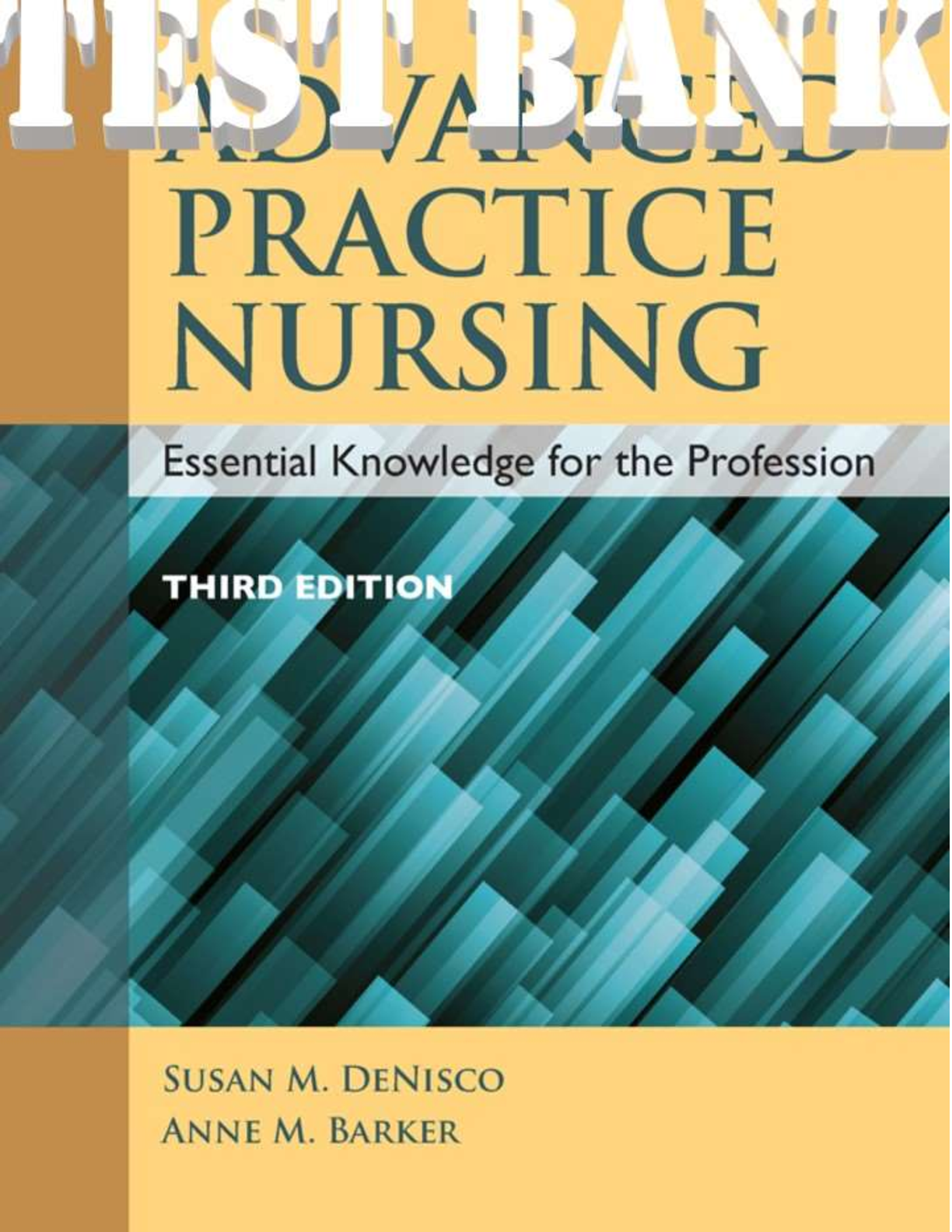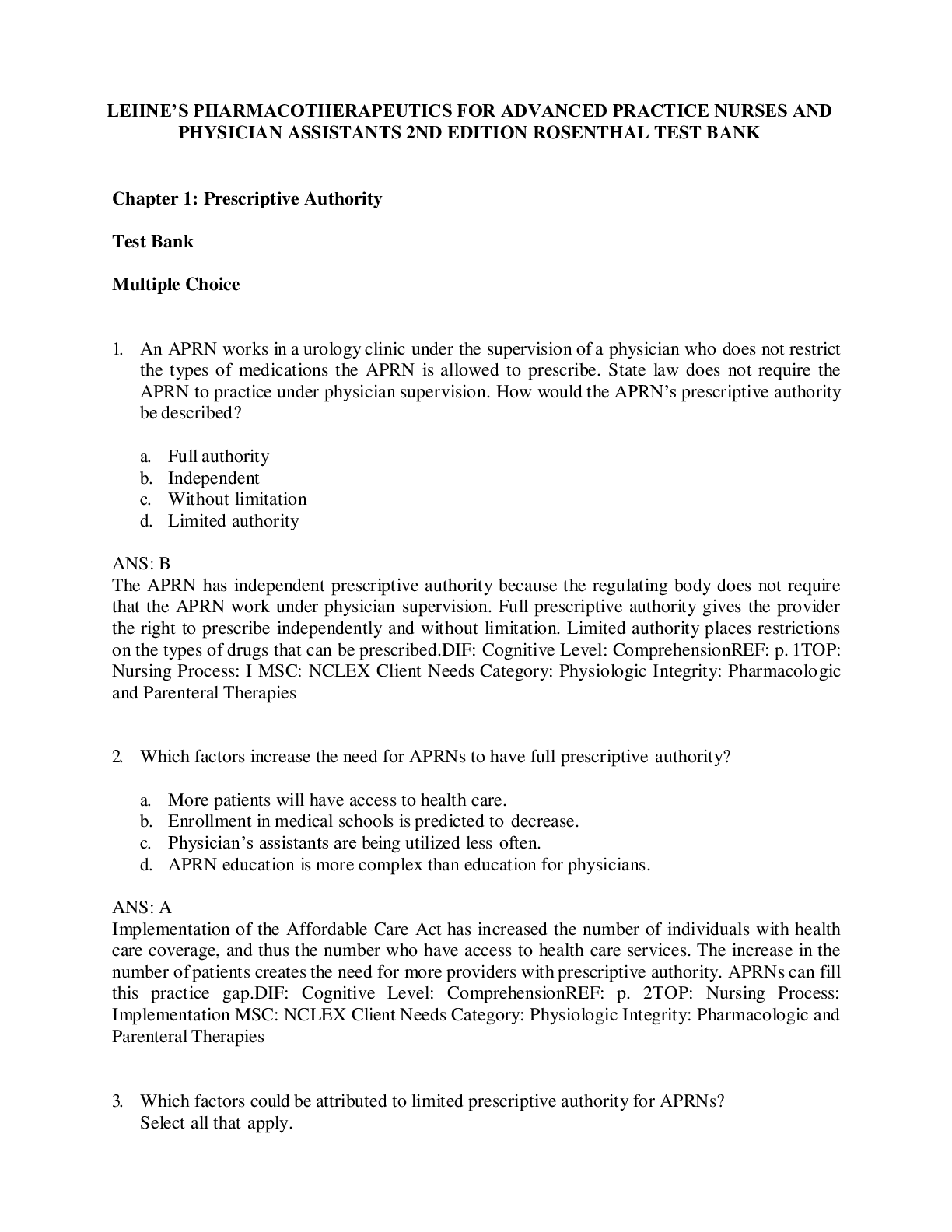*NURSING > TEST BANK > LEHNES PHARMACOTHERAPEUTICS FOR ADVANCED PRACTICE NURSES AND PHYSICIAN ASSISTANTS 2ND EDITION ROSEN. (All)
LEHNES PHARMACOTHERAPEUTICS FOR ADVANCED PRACTICE NURSES AND PHYSICIAN ASSISTANTS 2ND EDITION ROSEN. LATEST TEST BANK. GRADED A+
Document Content and Description Below
Chapter 1: Prescriptive Authority Test Bank Multiple Choice 1. An APRN works in a urology clinic under the supervision of a physician who does not restrict the types of medications the APRN is a... llowed to prescribe. State law does not require the APRN to practice under physician supervision. How would the APRN’s prescriptive authority be described? a. Full authority b. Independent c. Without limitation d. Limited authority ANS: B The APRN has independent prescriptive authority because the regulating body does not require that the APRN work under physician supervision. Full prescriptive authority gives the provider the right to prescribe independently and without limitation. Limited authority places restrictions on the types of drugs that can be prescribed.DIF: Cognitive Level: ComprehensionREF: p. 1TOP: Nursing Process: I MSC: NCLEX Client Needs Category: Physiologic Integrity: Pharmacologic and Parenteral Therapies 2. Which factors increase the need for APRNs to have full prescriptive authority? a. More patients will have access to health care. b. Enrollment in medical schools is predicted to decrease. c. Physician’s assistants are being utilized less often. d. APRN education is more complex than education for physicians. ANS: A Implementation of the Affordable Care Act has increased the number of individuals with health care coverage, and thus the number who have access to health care services. The increase in the number of patients creates the need for more providers with prescriptive authority. APRNs can fill this practice gap.DIF: Cognitive Level: ComprehensionREF: p. 2TOP: Nursing Process: Implementation MSC: NCLEX Client Needs Category: Physiologic Integrity: Pharmacologic and Parenteral Therapies 3. Which factors could be attributed to limited prescriptive authority for APRNs? Select all that apply. a. Inaccessibility of patient care b. Higher health care costs c. Higher quality medical treatment d. Improved collaborative care e. Enhanced health literacy ANS: A , B Limiting prescriptive authority for APRNs can create barriers to quality, affordable, and accessible patient care. It may also lead to poor collaboration among providers and higher health care costs. It would not directly impact patient’s health literacy.DIF: Cognitive Level: ComprehensionREF: p. 2TOP: Nursing Process: Implementation MSC: NCLEX Client Needs Category: Physiologic Integrity: Pharmacologic and Parenteral Therapies 4. Which aspects support the APRN’s provision for full prescriptive authority? Select all that apply. a. Clinical education includes prescription of medications and disease processes. b. Federal regulations support the provision of full authority for APRNs. c. National examinations provide validation of the APRN’s ability to provide safecare. d. Licensure ensures compliance with health care and safety standards. e. Limiting provision can decrease health care affordability. ANS: A , C , D APRNs are educated to practice and prescribe independently without supervision. National examinations validate the ability to provide safe and competent care. Licensure ensures compliance with standards to promote public health and safety. Limited prescriptive authority creates numerous barriers to quality, affordable, and accessible patient care.DIF: Cognitive Level: ComprehensionREF: pp. 1-2TOP: Nursing Process: Implementation MSC: NCLEX Client Needs Category: Physiologic Integrity: Pharmacologic and Parenteral Therapies 5. Which aspects support the APRN’s provision for full prescriptive authority? Select all that apply. a. Clinical education includes prescription of medications and disease processes. b. Federal regulations support the provision of full authority for APRNs. c. National examinations provide validation of the APRN’s ability to provide safecare. d. Licensure ensures compliance with health care and safety standards. ANS: A , C , D APRNs are educated to practice and prescribe independently without supervision. National examinations validate the ability to provide safe and competent care. Licensure ensures compliance with standards to promote public health and safety. Limited prescriptive authority creates numerous barriers to quality, affordable, and accessible patient care.DIF: Cognitive Level: ComprehensionREF: pp. 1-2TOP: Nursing Process: Implementation MSC: NCLEX Client Needs Category: Physiologic Integrity: Pharmacologic and Parenteral Therapies 6. A family nurse practitioner practicing in Maine is hired at a practice across state lines in Virginia. Which aspect of practice may change for the APRN? a. The APRN will have less prescriptive authority in the new position. b. The APRN will have more prescriptive authority in the new position. c. The APRN will have equal prescriptive authority in the newposition. d. The APRN’s authority will depend on federalregulations. ANS: A Virginia allows limited prescriptive authority, while Maine gives full authority to certified nurse practitioners. The federal government does not regulate prescriptive authority.DIF: Cognitive Level: ComprehensionREF: p. 3TOP: Nursing Process: Implementation MSC: NCLEX Client Needs Category: Physiologic Integrity: Pharmacologic and Parenteral Therapies Rosenthal: Lehne's Pharmacotherapeutics for Advanced Practice Providers, 2nd Ed. Chapter 2: Rational Drug Selection and Prescription Writing Test Bank Multiple Choice 7. How can collaboration with a pharmacist improve positive outcomes for patients? Select all that apply. a. Pharmacists can suggest foods that will help with the patient’s condition. b. Pharmacists have additional information on drug interactions. c. The pharmacist can suggest adequate medication dosing. d. Pharmacists have firsthand knowledge of the facility formulary. e. Pharmacy can alter prescriptions when necessary to prevent patient harm. ANS: B , C , D Providers should collaborate with pharmacists because they will likely have additional information on formulary, drug interactions, and suggestions for adequate medication dosing. Dietitians can make foods recommendations to treat the patient’s condition. The pharmacist can contact the prescriber about questionable prescriptions, but cannot alter the prescription without notification of and approval by the provider.DIF: Cognitive Level: ComprehensionREF: p. 9TOP: Nursing Process: Diagnosis MSC: NCLEX Client Needs Category: Physiologic Integrity: Reduction of Risk Potential 8. A patient presents with delirium tremens requiring Ativan administration. The provider of care is not in the facility. Which action by the nurse is most appropriate? a. Obtain a telephone order. b. Contact the on-call hospitalist. c. Obtain an order from the charge nurse. d. Wait for a written Ativan order. ANS: A In an emergency situation, such as delirium tremens with seizure activity, it is acceptable to provide a telephone order. Contacting the on-call hospitalist or waiting for a written order would take more time than available for a patient with high seizure risk. Writing an order is outside the scope of practice for the charge nurse.DIF: Cognitive Level: ApplicationREF: p. 7TOP: Nursing Process: Implementation MSC: NCLEX Client Needs Category: Physiologic Integrity: Reduction of Risk Potential 9. A patient with chronic pain calls the provider’s office to request a refill on theiroxycontin. Which action is most appropriate? a. Fax an order to the pharmacy. b. Schedule an appointment with the patient. c. Verify the patient’s adherence to drug regimen. d. Determine the patient’s current medication dosage. ANS: B Schedule II medications are not eligible for refills, and prescriptions must be handwritten. It is important to verify the patient’s adherence to the drug regimen and determine the current dosage of medication; however, this can be accomplished by scheduling an appointment and evaluating the patient in person.DIF: Cognitive Level: ApplicationREF: p. 8TOP: Nursing Process: Implementation MSC: NCLEX Client Needs Category: Physiologic Integrity: Reduction of Risk Potential 10. A patient prescribed amoxicillin for streptococcal pharyngitis reports new onset of a flat, itchy red rash on the chest and neck. Which action is most important? a. Provide a different prescription. b. Discontinue the medication. c. Prescribe an antihistamine cream. d. Assess for respiratory compromise. ANS: B The priority action is to discontinue the medication to prevent worsening of the patient’s symptoms. A different prescription would be provided, topical antihistamine may be administered, and the patient would be assessed for respiratory involvement, but these actions would not be performed first.DIF: Cognitive Level: ApplicationREF: p. 6TOP: Nursing Process: Implementation MSC: NCLEX Client Needs Category: Physiologic Integrity: Reduction of Risk Potential 11. A patient taking three medications for hypertension is diagnosed with COPD. Which action should be taken prior to prescribing medications to treat COPD? a. Obtain baseline laboratory values. b. Obtain a complete medication history. c. Assess liver enzyme levels. d. Determine if patient has insurance coverage. ANS: B Prior to adding medications to the treatment regimen, it is essential to assess for any potential drug- drug interactions through a complete medical history. Baseline laboratory values are not necessary for COPD treatment. Liver enzyme levels may give insight into the possibility of altered metabolism but would not be the first action. The presence of insurance coverage would affect the patient’s access to treatment but may not affect the type of medication prescribed.DIF: Cognitive Level: ApplicationREF: p. 6TOP: Nursing Process: Implementation MSC: NCLEX Client Needs Category: Physiologic Integrity: Reduction of Risk Potential 12. A patient with diabetes reports losing their job and an inability to purchase required medications. Which action is most appropriate? a. Provide a 7-day sample pack. b. Decrease the daily dose by half. c. Contact a different pharmacy. d. Prescribe a different medication. ANS: C Providing a 7-day sample will address the patient’s immediate need, but will not help with the patient’s long-term need for medication. Decreasing the daily dose will diminish the effectiveness of the medication. Selecting a different pharmacy could decrease the cost of the medication, as costs vary based on the location and the pharmacy dispensing the medication. Prescribing a different medication would be the last option.DIF: Cognitive Level: ApplicationREF: p. 5TOP: Nursing Process: Implementation MSC: NCLEX Client Needs Category: Physiologic Integrity: Reduction of Risk Potential 13. A patient recently prescribed hydrocodone calls to report theyare unable to fill the prescription. Which factors could contribute to the inability to fill the prescription? Select all that apply. a. DEA number missing from prescription b. Prescription sent via electronic messenger c. Dose higher than typically prescribed d. Prescriber license number not included e. Patient name and date of birth were handwritten ANS: A , B , D In order to fill a hydrocodone prescription, the prescriber name, license number, DEA number, and contact information must be included. Schedule II medications, such as narcotics, must be prescribed using written prescriptions. Though the pharmacist may question the high dosing, that would not prevent filling the prescription. The patient’s name and date of birth must be included on the prescription, but there are no regulations that the name cannot be handwritten.DIF: Cognitive Level: ComprehensionREF: pp. 6-8TOP: Nursing Process: Diagnosis MSC: NCLEX Client Needs Category: Physiologic Integrity: Reduction of Risk Potential Rosenthal: Lehne's Pharmacotherapeutics for Advanced Practice Providers, 2nd Ed. Chapter 3: Promoting Positive Outcomes of Drug Therapy Test Bank Multiple Choice 14. A patient reports that a medication prescribed for recurrent migraine headaches is not working. Which action should be taken first? a. Ask the patient about the number and frequency of tablets taken. b. Assess the patient’s headache pain on a scale from 1 to 10. c. Report the patient’s complaint to the prescriber. d. Suggest biofeedback as an adjunct to drug therapy. ANS: A When evaluating the effectiveness of a drug, it is important to determine whether the patient is using the drug as ordered. Asking the patient to tell the nurse how many tablets are taken and how often helps the nurse determine compliance. Assessing current pain does not yield information about how wellthe medication is working unless the patient is currently taking it. The nurse should gather as much information about compliance, symptoms, and drug effectiveness as possible before contacting the prescriber. Biofeedback may be an effective adjunct to treatment, but it should not be recommended without complete information about drug effectiveness.DIF: Cognitive Level: ApplicationREF: pp. 15-16TOP: Nursing Process: Evaluation MSC: NCLEX Client Needs Category: Physiologic Integrity: Pharmacologic and Parenteral Therapies 15. A patient is prescribed metronidazole for bacterial vaginosis. Which patient history finding would be most concerning? a. Recent yeast infection b. Family history of cervicalcancer c. Drinks two glasses of wine every night d. Patient is currently unemployed ANS: C Patients taking metronidazole should be educated not to drink alcohol to prevent adverse reactions. It would be concerning that the patient drinks wine daily. History of a yeast infection may indicate increased risk for recurrence with administration of an antimicrobial. A family history of cervical cancer is not related to administration of metronidazole. Unemployment can indicate lack of insurance coverage, which may limit the patient’s ability to purchase medications, but is not the most concerning patient finding.DIF: Cognitive Level: ApplicationREF: p. 12TOP: Nursing Process: Implementation MSC: NCLEX Client Needs Category: Physiologic Integrity: Reduction of Risk Potential 16. A patient is using a metered-dose inhaler containing albuterol for asthma. The medication label instructs the patient to administer “two puffs every 4 hours as needed for coughing or wheezing.” The patient reports feeling jittery sometimes when taking the medication, and she doesn’t feel that the medication is always effective. Which action is most appropriate? a. Asking the patient to demonstrate use of the inhaler b. Assessing the patient’s exposure to tobacco smoke c. Auscultating lung sounds and obtaining vitalsigns d. Suggesting that the patient use one puff to reduce side effects ANS: C Asking the patient to demonstrate inhaler use helps to evaluate the patient’s ability to administer the medication properly and is part of the nurse’s evaluation, but is not a priority intervention based on the patient’s current report. Assessing tobacco smoke exposure helps the nurse determine whether nondrug therapies, such as smoke avoidance, can be used as an adjunct to drug therapy, but does not relate to the patient’s current problem. Performing a physical assessment helps the nurse evaluate the patient’s response to the medication and identify the presence of other side effects.DIF: Cognitive Level: ApplicationREF: p. 13TOP: Nursing Process: Implementation MSC: NCLEX Client Needs Category: Physiologic Integrity: Pharmacologic and Parenteral Therapies 17. A patient newly diagnosed with diabetes is to be discharged from the hospital. Which action should be taken first during medication education? a. Asking the patient to demonstrate how to measure and administer insulin b. Discussing methods of storing insulin and discarding syringes c. Giving information about how diet and exercise affect insulin requirements d. Teaching the patient about the long-term consequences of poor diabetes control ANS: A Because insulin must be given correctly to control symptoms and because an overdose can be fatal, it is most important for the patient to know how to administer it. Asking for a demonstration of technique is the best way to determine whether the patient has understood the teaching. When a patient is receiving a lot of new information, the information presented first is the most likely to be remembered. The other teaching points are important as well, but they are not as critical and can be taught later.DIF: Cognitive Level: ApplicationREF: p. 11TOP: Nursing Process: Planning MSC: NCLEX Client Needs Category: Physiologic Integrity: Reduction of Risk Potential 18. The drug manual states that older adult patients are at increased risk for hepatic side effects. Which action is most important when prescribing this medication to an 80-year-old patient? a. Obtain pretreatment laboratory work. b. Ensure that the drug is given in the correct dose at the correct time to minimize the risk of adverse effects. c. Discontinue the order; the drug is contraindicated for this patient. d. Give the medication intravenously so that the drug does not pass through the liver. ANS: A The drug manual indicates that this drug should be given with caution to elderly patients. Getting information about liver function before giving the drug establishes baseline data that can be compared with post-treatment data to determine whether the drug is affecting the liver. Giving the correct dose at the correct interval helps to minimize risk, but without baseline information, the effects cannot be determined. The drug is not contraindicated.DIF: Cognitive Level: AnalysisREF: p. 12TOP: Nursing Process: Implementation MSC: NCLEX Client Needs Category: Physiologic Integrity: Reduction of Risk Potential 19. A patient recently diagnosed with HIV is prescribed several medications to treat the condition. Which factors could impact the patient’s adherence to the treatment regimen? Select all that apply. a. The patient is uninsured b. The patient works three part-time jobs c. The medication regimen includes six different pills d. Patient has an eighth-grade reading comprehension level e. Medication regimen requires medication be taken at regular 4-hour intervals. ANS: A , B , C , E Lack of insurance coverage can inhibit the patient from purchasing the medications, limiting his access to treatment. Having three part-time jobs indicates that the patient has a busy schedule, which contributes to forgetfulness and poor adherence. The more complex the medication regimen, the more difficult it is to maintain patient adherence. Although a patient with an eighth-grade reading comprehension level may have difficulty understanding professional medical language, medication teaching can be adjusted to meet the patient’s learning needs.DIF: Cognitive Level: ComprehensionREF: pp. 13-14TOP: Nursing Process: Evaluation MSC: NCLEX Client Needs Category: Physiologic Integrity: Reduction of Risk Potential 20. A patient diagnosed with bipolar disorder is prescribed daily lithium. Which action is most important to determine if the therapeutic level is maintained? a. Obtain preadministration blood work. b. Administer medication at regular intervals. c. Ensure periodic laboratory testing is completed. d. Assess the patient for adverse effects. ANS: C Therapeutic serum levels are determined through periodic laboratory testing. Preadministration blood work may be necessary to determine the patient’s physical condition but will not determine therapeutic levels. Scheduling medication administration at regular intervals will help to ensure medication is absorbed and metabolized predictably, but will not determine therapeutic blood levels. Assessing the patient for physical signs of adverse effects does not determine if a therapeutic level has been obtained.DIF: Cognitive Level: ApplicationREF: p. 12TOP: Nursing Process: Evaluation MSC: NCLEX Client Needs Category: Physiologic Integrity: Reduction of Risk Potential Rosenthal: Lehne's Pharmacotherapeutics for Advanced Practice Providers, 2nd Ed. Chapter 4: Pharmacokinetics, Pharmacodynamics, and Drug Interactions Test Bank Multiple Choice 21. The nurse administers naloxone [Narcan] to a patient who has received a toxic dose of morphine sulfate. The nurse understands that the naloxone is effective because of which action? a. Countering the effects of morphine sulfate by agonist actions b. Increasing the excretion of morphine sulfate by altering serum pH c. Preventing activation of opioid receptors through antagonist actions d. Regulating the sensitivity of opioid receptors by neurochemicalalterations ANS: C Naloxone acts by blocking the action of opioids at opioid receptors. An opioid agonist would increase the effects of morphine. Naloxone does not affect serum pH or excretion of opioids. Naloxone does not alter the sensitivity of opioid receptors.DIF: Cognitive Level: AnalysisREF: p. 31TOP: Nursing Process: Implementation MSC: NCLEX Client Needs Category: Physiologic Integrity: Pharmacologic and Parenteral Therapies e. lower; X f. lower; Y g. higher; X h. higher; Y ANS: C An inducing agent stimulates the synthesis of CYP isoenzymes, which may increase the metabolism of other drugs as much as two- to threefold, thereby lowering the level of those drugs in the body and requiring higher doses to maintain drug effectiveness.DIF: Cognitive Level: ApplicationREF: p. 36TOP: Nursing Process: Planning MSC: NCLEX Client Needs Category: Physiologic Integrity: Pharmacologic and Parenteral Therapies 22. The nurse is preparing to administer penicillin G intramuscularly to a child. The child’s parents ask why the drug cannot be given in an oral liquid form. What is the nurse’s reply? a. “This drug causes severe gastric upset if given orally.” b. “This drug has a narrow therapeutic range, and the dose must be tightly controlled.” c. “This drug is absorbed much too quickly in an oral form.” d. “This drug would be inactivated by enzymes in the stomach.” ANS: D Penicillin G is inactivated by digestive enzymes in the stomach and cannot be given orally. It does not have a narrow therapeutic range.DIF: Cognitive Level: ApplicationREF: p. 20TOP: Nursing Process: Implementation MSC: NCLEX Client Needs Category: Physiologic Integrity: Pharmacologic and Parenteral Therapies 23. Which statement about food and drug interactions is true? a. Foods alter drug absorption and metabolism but not drug action. b. Medications are best absorbed on an empty stomach. c. Patient discomfort is the food and drug interaction of most concern. d. Some foods can inhibit CYP isoenzymes and alter drug metabolism. ANS: D Grapefruit juice inhibits CYP3A4, which lowers the metabolism of some drugs, leading to toxic effects of drugs affected by these isoenzymes. Foods can alter all pharmacokinetic and pharmacodynamic processes. Not all medications are absorbed better on an emptystomach; some require certain foods to enhance absorption. Patient comfort is a concern, but it is not asimportant as more severe and possibly life-threatening food and drug interactions.DIF: Cognitive Level: AnalysisREF: p. 39TOP: Nursing Process: Assessment MSC: NCLEX Client Needs Category: Physiologic Integrity: Reduction of Risk Potential 24. A nurse is teaching a patient about a drug that induces P-glycoprotein. The nurse will explain that this drug may cause which effect on other drugs? a. Decreased absorption in the intestines b. Decreased elimination through the kidneys c. Increased brain exposure d. Increased fetal absorption ANS: B Drugs that induce PGP can increase drug export from cells of the intestinal epithelium into the intestinal lumen, thus decreasing absorption of the drug. PGP inducers also increase drug elimination and decrease brain and fetal drug exposure.DIF: Cognitive Level: AnalysisREF: p. 36TOP: Nursing Process: Assessment MSC: NCLEX Client Needs Category: Physiologic Integrity: Pharmacologic and Parenteral Therapies 25. A patient claims to get better effects with a tablet of Brand X of a drug than with a tablet of Brand Y of the same drug. Both brands contain the same amount of the active ingredient. What does the nurse know to be most likely? a. Advertising by pharmaceutical companies can enhance patient expectations ofone brand over another, leading to a placebo effect. b. Because the drug preparations are chemically equivalent, the effects of the two brands must be identical. c. Tablets can differ in composition and can have differing rates of disintegration and dissolution, which can alter the drug’s effects in the body. d. The bioavailability of a drug is determined by the amount of the drug in eachdose. ANS: C Even if two brands of a drug are chemically equivalent (i.e., they have identical amounts of the same chemical compound), they can have different effects in the body if they differ in bioavailability. Tablets made by different manufacturers contain different binders and fillers, which disintegrate and dissolve at different rates and affect the bioavailability of the drug. Two brands may be chemically equivalent and still differ in bioavailability, which is not determined by the amount of drug in the dose.DIF: Cognitive Level: ApplicationREF: p. 19TOP: Nursing Process: Diagnosis MSC: NCLEX Client Needs Category: Physiologic Integrity: Pharmacologic and Parenteral Therapies 26. Two nurses are discussing theories of drug-receptor interaction. Which statements are true regarding the affinity of a drug and its receptor? Select all that apply. a. Affinity and intrinsic activity are dependent properties. b. Affinity refers to the strength of the attraction between a drug and its receptor. c. Drugs with high affinity are strongly attracted to their receptors. d. Drugs with low affinity are strongly attracted to their receptors. e. The affinity of a drug for its receptors is reflected in its potency. ANS: B , C , E Affinity refers to the strength of the attraction between a drug and its receptor. Drugs with high affinity are strongly attracted to their receptors, and the affinity of a drug and its receptors is reflected in its potency. Affinity and intrinsic activity are independent properties. Drugs with low affinity are weakly attracted to their receptors.DIF: Cognitive Level: ComprehensionREF: pp. 30- 31TOP: Nursing Process: Diagnosis MSC: NCLEX Client Needs Category: Physiologic Integrity: Pharmacologic and Parenteral Therapies 27. A patient receives a drug that has a narrow therapeutic range. The nurse administering [Show More]
Last updated: 1 year ago
Preview 1 out of 479 pages
Instant download
.png)
Buy this document to get the full access instantly
Instant Download Access after purchase
Add to cartInstant download
Reviews( 0 )
Document information
Connected school, study & course
About the document
Uploaded On
Mar 19, 2022
Number of pages
479
Written in
Additional information
This document has been written for:
Uploaded
Mar 19, 2022
Downloads
0
Views
80



.png)
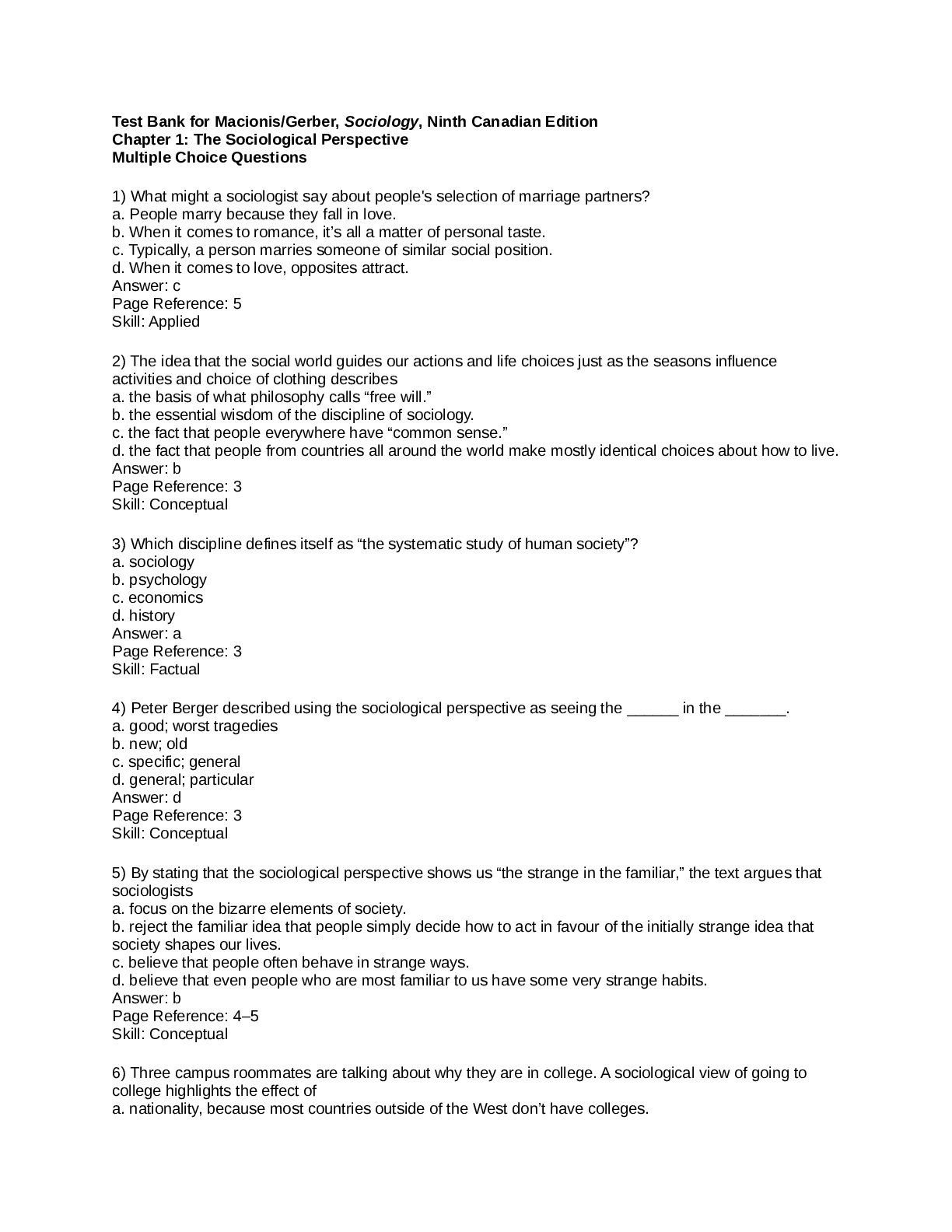
.png)
.png)
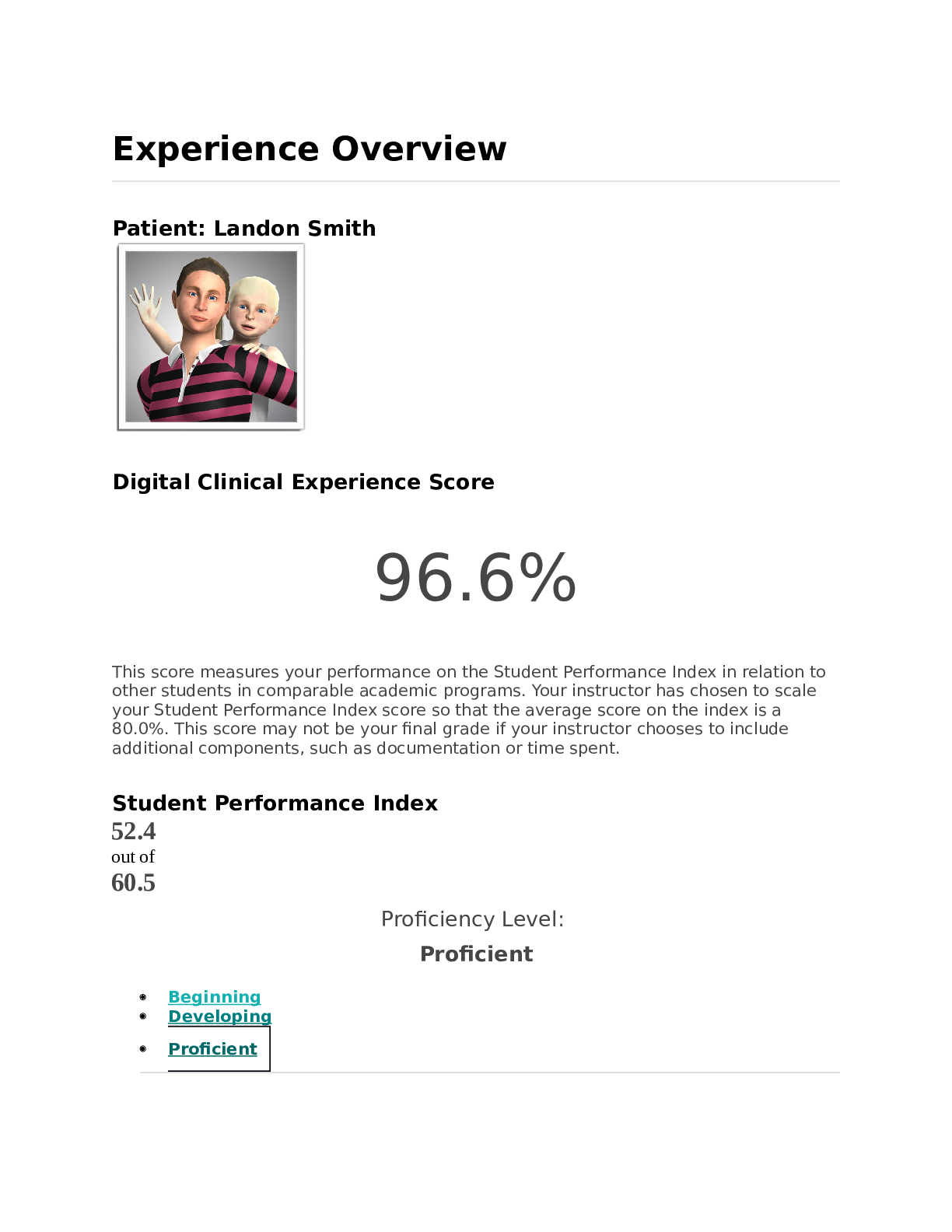
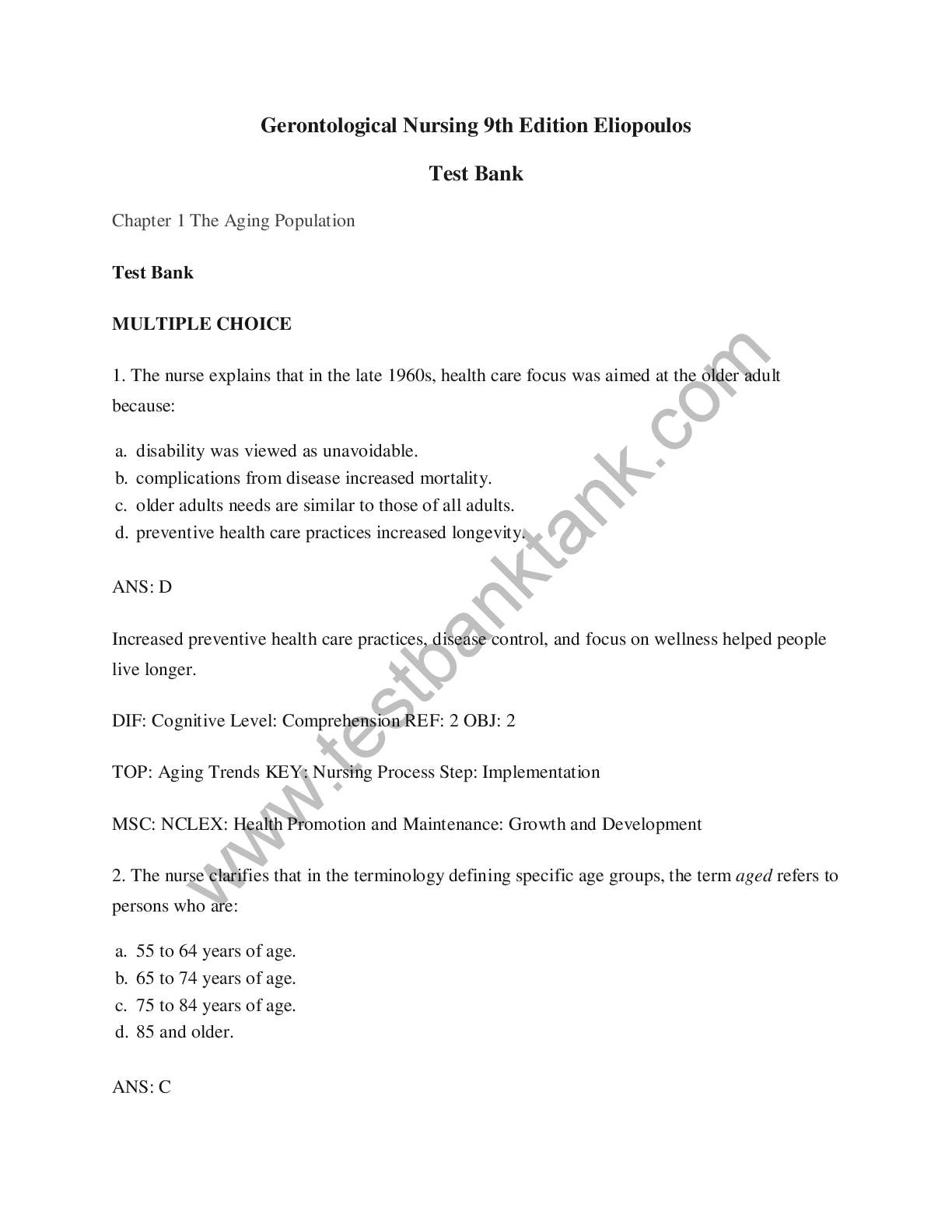

.png)
